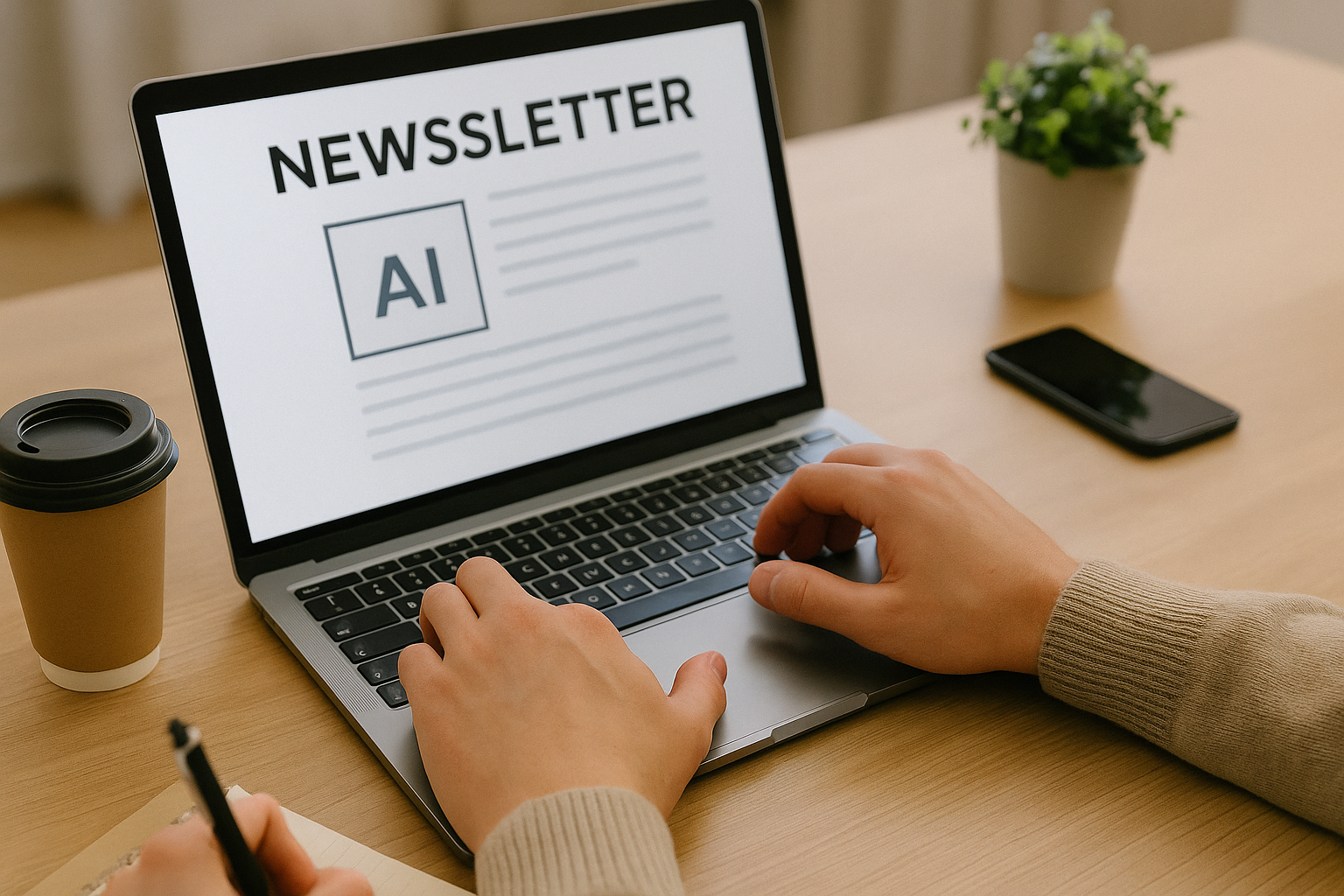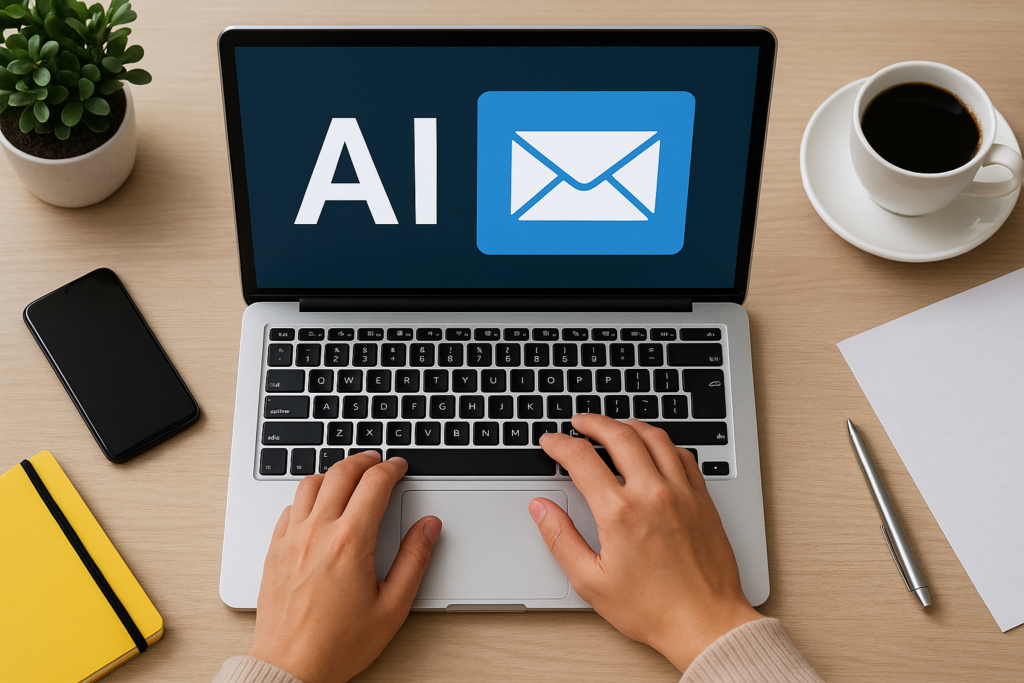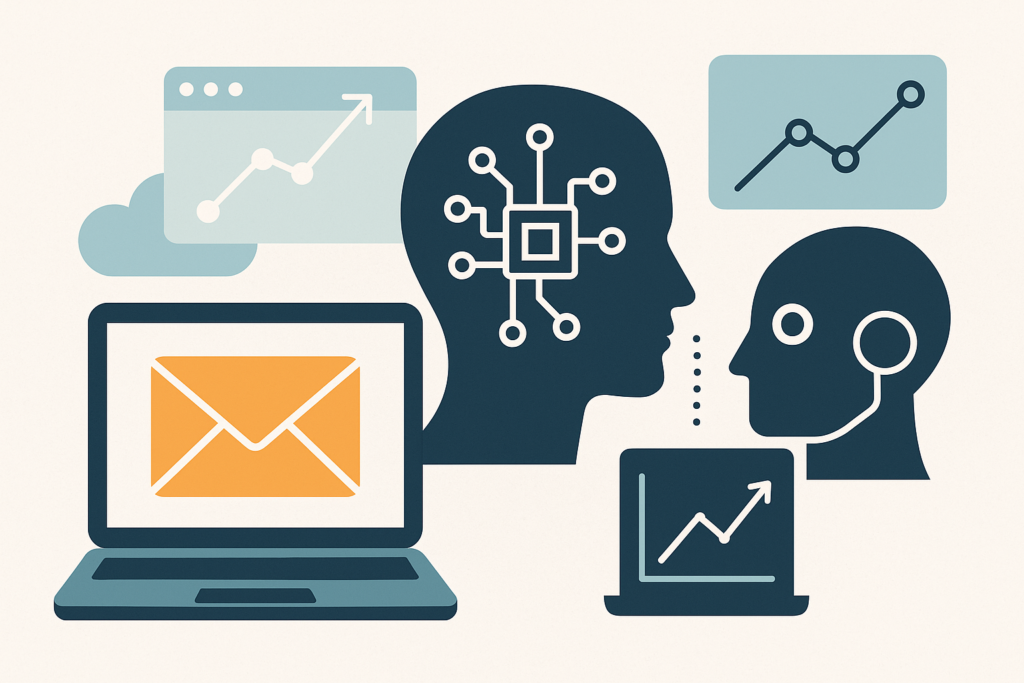Physical Address
304 North Cardinal St.
Dorchester Center, MA 02124
Physical Address
304 North Cardinal St.
Dorchester Center, MA 02124

AI-powered newsletters are quickly becoming the future of email marketing in 2025. Imagine this: you wake up, check your email and one message stands out. It’s not flashy, but it feels personal like it was made just for you. It talks about the things you’re interested in, even reminding you of something you recently searched for. This is the magic of AI at work.
A few years ago, creating and sending newsletters took a lot of time and effort. Marketers had to write the content, design the layout, and decide when to send it out—all by hand. But now, AI is making this process faster and more effective. It helps businesses send out emails that are more relevant and timely for their readers.
In this blog, you’ll learn how AI is changing email marketing, how to use AI for your newsletters, the best tools to automate the process, and what the future holds for AI-powered newsletters. But there’s one big mistake you must avoid if you want your efforts to succeed. Whether you’re new to email marketing or want to improve your current strategy, this guide will help you stay ahead.
Let’s explore how AI can take your newsletters to the next level.
AI-powered newsletters are transforming the way businesses communicate with their audience. Think about the last time you received a newsletter. Was it something you were genuinely interested in, or did you quickly scroll past it? In the past, newsletters were often sent out to large groups, with little thought about the individual needs of each person. But today, AI has changed that.
AI allows marketers to send newsletters that feel more personal, tailored to each reader. It can analyze past behaviors, interests, and even the best times to send emails for each person. This means that newsletters aren’t just a one-size-fits-all approach anymore. With AI, companies can deliver messages that feel more like a conversation, not just a sales pitch.
In 2025, this level of personalization is becoming more common, and it’s showing results. Businesses using AI-powered newsletters have seen higher open rates, more clicks, and better engagement from their subscribers. It’s not just about making newsletters look better; it’s about making them more effective.
By using AI, businesses can save time and effort while ensuring their messages reach the right people at the right time. Whether it’s through improved targeting, content suggestions, or scheduling, AI-powered newsletters are the future of digital marketing. This shift makes it possible for companies to stay relevant and connected with their audience, even as expectations continue to grow.
In 2025, how AI is transforming email marketing goes beyond just sending emails. AI is revolutionizing the way we think about engagement, personalization, and automation. Imagine being able to understand your audience so well that every email feels like it was created specifically for them. That’s what AI brings to the table.
One of the key ways AI is transforming email marketing is through personalization at scale. Traditional email marketing often involved sending the same message to everyone on a list. But with AI, businesses can analyze subscriber data—like past purchases, browsing behavior, and even how they interact with previous emails—and use that information to tailor the content for each individual. This makes each email feel more relevant and meaningful.
AI also takes care of tasks like automated content creation. Instead of spending hours crafting the perfect subject line or writing copy for every email, AI tools can help generate content based on what your audience is most likely to engage with. For example, if a subscriber recently looked at a specific product on your website, AI can automatically send them an email with that product and similar suggestions.
Moreover, AI can handle send-time optimization. Instead of guessing when is the best time to send an email, AI can analyze past data to determine when each subscriber is most likely to open and engage with your email. This kind of precision helps increase open rates and improve overall campaign performance.
With these capabilities, AI is not just a tool for efficiency—it’s a powerful driver of engagement, helping marketers build stronger, more personalized connections with their audience.

Now that you know how powerful AI is in transforming email marketing, let’s dive into how to use AI for newsletters. Getting started with AI-powered newsletters doesn’t have to be complicated, and with the right tools, it can save you time and boost your results. Here’s a simple step-by-step guide to help you harness the power of AI in your email campaigns:
The first step is selecting the right AI-powered newsletter tool. There are many platforms that integrate AI into their email marketing systems, such as Mailchimp, ConvertKit, or ActiveCampaign. Look for a tool that allows for automated content creation, segmentation, and send-time optimization.
AI works best when it has data to work with. Make sure your subscribers are properly segmented based on their behavior, preferences, and previous interactions with your emails. For example, segment them based on their location, purchase history, or interests. This ensures that the AI can personalize each email effectively.
With your AI tool set up, you can begin automating content creation. Many AI tools can suggest subject lines, write copy, or even recommend images based on the data collected from your subscribers. You can customize these suggestions to match your brand’s tone and style.
One of the most powerful features of AI is its ability to optimize the best times to send your newsletters. Rather than guessing when your subscribers are most likely to open your emails, AI analyzes their past behavior and schedules the emails to land in their inbox at the perfect moment.
After your AI-powered newsletters are sent, track how they perform. Most AI tools provide detailed analytics, such as open rates, click-through rates, and engagement metrics. Use this data to continuously refine your email campaigns for better results.
By following these steps, you’ll be able to take full advantage of AI to create personalized, automated, and efficient newsletters.
When it comes to creating consistent and engaging newsletters, automated newsletter tools make the job easier and more efficient. These tools don’t just save time—they also improve accuracy and help deliver better results. Let’s take a look at some of the most reliable options available in 2025 that make use of AI technology.
One of the most popular email platforms, Mailchimp now offers AI features like subject line suggestions, personalized send-time optimization, and smart content recommendations. It’s ideal for small to medium-sized businesses that want an easy, powerful solution.
ActiveCampaign takes automation to the next level by using AI to monitor subscriber behavior in real-time. If a user opens an email or clicks a link, the system updates its actions and messaging automatically—perfect for creating responsive campaigns.
GetResponse is known for its all-in-one AI-powered platform. It supports everything from smart automation to personalized content suggestions, making it a top choice for marketers looking to scale up without losing the human touch.
With a focus on simplicity and performance, Benchmark Email offers AI features that enhance subject lines, layout, and engagement tracking. It’s a strong option for users who want clean, effective automation with minimal setup.
HubSpot combines powerful AI tools with its CRM system to create fully personalized email journeys. From segmentation to A/B testing and predictive analytics, HubSpot helps marketers fine-tune their strategy with data-driven insights.
These AI-powered newsletter tools help ensure your emails reach the right audience with the right message—automatically.
In 2025, more businesses are turning to AI-powered newsletters because of the clear benefits they bring to email marketing. From saving time to improving results, the impact of AI is easy to see once it’s in action.
The first big advantage is personalization. AI tools can look at how each subscriber interacts with past emails—what they clicked, what they ignored, and even what time they opened the message. Based on this, the system creates emails that feel personal and relevant. Instead of one message for everyone, each person gets something tailored to them.
Another benefit is automation. With AI, you don’t have to manually write every subject line or figure out the best time to send an email. The system takes care of these tasks for you. Some tools can even generate content suggestions, choose images, or rearrange sections of an email to increase engagement.
AI also brings better timing. Many platforms offer features like send-time optimization, where each subscriber gets the email at the time they’re most likely to open it. This means better open rates and more chances of clicks.
Then there’s data insight. AI doesn’t just send emails—it learns from what happens afterward. If fewer people open one type of content, it adjusts. If another message does well, it leans into that style. This continuous improvement means your newsletters get smarter and more effective over time.
Finally, AI helps reduce manual work. You spend less time designing emails, guessing what to say, or worrying about your results. This lets you focus on bigger-picture strategies like audience growth and content quality.
By combining all these benefits, AI-powered newsletters give businesses a real edge—more engagement, less stress, and smarter communication.
As helpful as AI-powered newsletters can be, there’s one mistake many marketers make—and it can seriously damage your results.
That mistake is relying too much on automation and forgetting the human touch.
AI tools are great at saving time and generating content, but they can’t fully understand your brand’s voice, your audience’s emotions, or the subtle cultural context that makes communication truly meaningful. When businesses let AI handle everything—from writing to sending—emails can start to feel cold, generic, or even confusing.
For example, you might use AI to suggest a subject line, but if that line doesn’t sound like something your brand would normally say, it can confuse your readers. Worse, subscribers may stop opening your emails altogether if they start to feel impersonal or overly mechanical.
To avoid this, always review and adjust what the AI creates. Use it as a helper—not a replacement. Keep your voice consistent, add real stories or insights when possible, and speak directly to your audience in a way that feels natural. People connect with people, not robots.
It’s also important to regularly check your metrics. Don’t assume AI will always get it right. Watch open rates, click-through rates, and feedback to understand what your audience actually responds to. Then fine-tune your emails accordingly.
AI should be your assistant, not your content manager. The best results happen when human creativity and AI efficiency work together.

AI-powered newsletters are already changing the way businesses communicate, but the journey doesn’t stop here. Looking ahead, we can expect even smarter tools, deeper personalization, and tighter connections between email marketing and other platforms.
One trend on the rise is predictive content, where AI not only reacts to what a subscriber has done—but predicts what they’ll want next. For example, if someone reads a blog post about SEO tools, your next newsletter might automatically suggest a related guide or service. This kind of forward-thinking content keeps people engaged longer and boosts conversion rates.
Another exciting development is cross-channel integration. Email won’t exist in a vacuum. AI tools are starting to connect newsletters with social media, chatbots, websites, and even voice assistants. Your newsletter might adjust its message based on a customer’s recent Instagram activity or live chat interaction.
We’ll also see improvements in AI ethics and transparency. As people become more aware of how their data is used, platforms will need to explain how AI makes decisions. This will build trust and lead to more meaningful engagement.
And finally, small businesses will have even more access to enterprise-level AI tools—helping them compete with larger brands. No more guessing what works. Just smart, data-driven newsletters that connect and convert.
If you’re looking to explore the best AI tools and strategies for your content, you can learn more and get tailored guidance at icebergaicontent.com—a growing resource for businesses that want to simplify content marketing with AI.
The future of email marketing is here—and it’s powered by AI. Are you ready to make the most of it?